
Colorado is set to pay out more than $3.5 billion in TABOR refunds next spring — one of the largest paybacks that the state has ever had to return to taxpayers.
In fact, the state is in the middle of what could be a record-busting string of revenue years. For the first time ever, the state government could be forced to pay refunds for six straight years, stretching from 2022 through 2027 or longer. Those refunds are expected to average more than $2 billion per year — a level never before seen in Colorado, even accounting for inflation.
“We are now in the crazy, crazy TABOR surplus era,” said Scott Wasserman, president of the progressive Bell Policy Center.
Late 2022 through 2024 will likely be the peak of the refund wave, due largely to pandemic-era gains in personal and corporate income. But TABOR paybacks could remain a fixture in Colorado long after that, said chief legislative economist Greg Sobetski.
Even a moderate level of economic growth will likely push the state over the revenue limits set by the Taxpayer’s Bill of Rights, forcing it to send that extra money back, Sobetski said. A recession would likely only lead to a temporary break in the TABOR surpluses, he added.
“I think as the economy grows at a normal pace, that we should see larger TABOR refund obligations over time, and that is in fact what we're seeing,” Sobetski said in an interview.
However, those numbers could change, especially if Prop. HH passes this November. The ballot measure is being marketed as a property tax reduction, but it also contains big changes for TABOR’s revenue limits.
If enacted, HH would trigger a law to temporarily “flatten out” refunds, resulting in everyone getting an equal payout in 2024 regardless of what taxes they paid in. The universal refunds would be about $900 that year — a gain for most people, but a relative loss of thousands of dollars for wealthier taxpayers.
Over a longer period of about a decade, Prop. HH also could reduce refunds by an amount ranging up to the billions of dollars, allowing the state to send much of that money to the state education fund instead.
A political paradox for Democrats?
Unsurprisingly, refunds are pretty popular. They consistently draw major media attention, and articles about them are well read. After all, who doesn’t like finding a few hundred tax dollars in their proverbial back pocket?
To former Gov. Bill Owens, a Republican, this bumper crop of refunds is a sign that the state’s fiscal limits are working.
“TABOR is very popular in Colorado, and I think at some level the electorate understands, ‘Hey, government has to give us back money if it gets more than it needs,’” he said in a recent interview.
Democrats, who now dominate state politics, have also celebrated the refunds in recent years, with Gov. Jared Polis branding them as the “Colorado Cashback” and sending out bushels of checks with a signed letter last year.
At the same time, though, refunds pose a vexing question for liberals and progressives in state politics, who believe some or all of that money would be better spent through targeted state programs. Some worry that the yearly payouts will become an expectation.
“Now [refunds] are in the political rhetoric. There's this built-in expectation of ‘my TABOR,’” Wasserman said. “So the TABOR surplus, which was an on-again, off-again situation for two decades, is now considered to be a right.”
Wasserman and other advocates have long argued that the refunds are the product of a broken system. They say that the state’s revenue limits are simply too tight, and that paying refunds comes at the cost of important services like education.
“The revenue limit at the end of the day is always going to be too restrictive. It doesn't tie to what the government really needs to do and to a changing economy, to a changing environment. That limit is 30 years old. And you can see compared to other states, many things that we don't do in Colorado or we do very inefficiently,” said Kathy White, executive director of the left-leaning Colorado Fiscal Institute.
Failed efforts to change refunds — and a couple successes
The refunds have been part of Colorado’s political life since 1992, when voters passed the Taxpayer’s Bill of Rights.
The constitutional amendment says that Colorado’s discretionary budget can only grow at a rate determined by inflation and population growth. If tax revenues increase too fast, the state ends up with a “TABOR surplus” that must go back to taxpayers. That’s happened in 11 years out of the roughly three decades since TABOR took effect. The amendment lays out a complex system for returning money, which most often results in a mix of tax credits, reductions and, most visibly, direct payments.
Over the years, there have been only a couple major changes to refunds.
Most notably, there was Ref. C in 2005. The state was recovering from the early 2000s recession, but the design of TABOR meant that the revenue limit had been “ratcheted down” and remained stuck at the lower recession level.
A bipartisan coalition, including then-governor Owens, argued that without changes, the state’s finances would never really catch up. The measure passed, resulting in a substantially higher revenue limit, getting rid of the ratchet-down effect and allowing the state to retain more than $30 billion in the years since.
“That was a conscious, well-debated decision by the electorate and the general assembly, and it was done with full recognizance of the impact,” Owens said — though the measure still led to blowback from conservatives.
Another reform came in 2022, when voters agreed to give some refund money for affordable housing through Prop. 123.
Democrats also have made changes to the refunds themselves, including temporarily eliminating the income-tiered rebate system and instead paying equal TABOR surplus checks to all taxpayers in 2022 and potentially 2024 — a major victory for progressives.
Flat refunds are “the one progressive thing that we can do [under TABOR], which is hand money directly to citizens who really need it,” said progressive organizer Deep Badhesha.
But one of the biggest reform proposals was a bust.
In 2019, Democrats tried and failed to convince voters to permanently eliminate TABOR’s state spending limits and refunds, with the additional money targeted for education and transportation instead. It failed by about 7 percentage points — a sign that spending limits remain a tough nut to crack, despite Democrats’ growing power.
The next big fight is Prop. HH
Now, Democrats are trying a different approach with Prop. HH. The measure is being marketed primarily as a cut to property tax rates. But it would also raise the state’s revenue limits — first by a little, and later by more.
By 2033, it would allow Colorado to retain an extra $2.2 billion per year that otherwise would have to be refunded. That money would be used to ensure that school funding isn’t negatively affected by the reduction in property tax rates, and that local government impacts are somewhat reduced too.
But beyond that, it also could take hundreds of millions, or billions, from the TABOR surplus and turn it into new money for public education, depending how the economy performs.
If lawmakers chose to keep the measure in place even longer, it could eventually raise the limit by about $6 billion by 2040, according to modeling from the pro-business Common Sense Institute. That would put a significant dent in TABOR refunds. But lawmakers or voters could move to defuse the change before then.
For now, the proposition is at the center of an intense political fight, with close to $1 million raised on each side already. Supporters argue it’s a good deal — giving up the mere potential for billions of dollars of refunds for the guarantee of billions of dollars in property tax reductions, with whatever’s left over going to schools.
“How are we going to solve this issue that communities are having, and why not look at the TABOR surplus?” Wasserman said. “Why shouldn't the TABOR surplus, which comes to us with no change in the existing tax rate … be a pot of money that we are allowed to look at?”
Badhesha said the idea of raising the TABOR limits made him a “reluctant yes” on Prop. HH, despite its minimal benefits for renters. “It's still a moderate fiscal policy proposal, but one of the best things about Prop. HH is we're going to be able to take all this extra TABOR surplus revenue and direct it to education,” he said.
Conservative critics, meanwhile, say the measure is merely using property tax cuts as bait to loosen TABOR limits and drain the refund pool. And they point out that while the tax cut will only benefit those with the means to own property, TABOR refunds go to everyone.
“This brief respite of six years [of TABOR refunds] was more than my friends on the left could handle,” Owens said. “And so now they have decided to take it on through subterfuge. And that's actually what I believe HH is.”
On Nov. 7, voters will decide which message they believe — and perhaps change the trajectory of TABOR while they’re at it.









